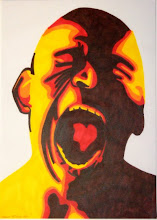I have a conflict as a filmmaker, one that upsets the tested tradition of how a film should be approached and realized. I have always been a total audiophile, and when discussing other's work, or in developing my own films, I start from the ear and move on to the eyes. This has always been a problematic fixation for me, as stressing the importance of the image seems to be the prevailing orientation for most theory and criticism. So, when given the opportunity to discuss the act of listening to film, I tend to go quite happily overboard...
All of the films we viewed during our discussion of sound in Avant-Garde cinema in my lecture class today had me hypnotized. Whether the score was erratic and impulsive, or haunting and atmospheric, each film is worth discussing in detail. I will try to write one short paragraph about each.

(1) The Edison Kinetescope Films - To find a film that predates the modern timetable of when sound in film was introduced must have been breathtaking. I have never been so fired up about a fiddle in my life. The surprisingly clean recording on brown wax has twice the majesty of sound alone from that era, because of its visual counterpart. I especially like that the massive early phonograph is so present in the frame, in that you can actually see the first synching of sound literally being produced in the image.

(2) Gus Visser and His Singing Duck - Again the quality of this recording exceeds expectations. The image marries the staged, vaudevillian ethos of the early Edison work, with a truly remarkable synch-sound recording.

(3) M - Fritz Lang's brilliant habit of pushing ahead of his time mechanically makes this film a breakthrough in sound design. He utilizes not only negative image space, but also negative sound space to create tension and pass time. The moments of muted horror punctuate the suffocating images he creates, and make "M" a remarkable and terrifying picture.

4) The Third Man - A film that also makes use of astounding imagery as well as impeccable sound, the atmosphere that Carol Reed intends to create is in fact realized by the harmonious nature of the score and sparse but effective sound with the grandiose nature of the footage. A truly wonderful joining of sound and image.

5) Ballet Mecanique - Though I disliked the "mechanics" of the score, what with its lack of order within disorder and its penchant for horns and bells that in my opinion are not well executed or composed, I am able to forgive the maker because of how well the sound matches the pace and rhythm of the imagery. Each bell and whistle carries quite perfectly with the edit and physical patterns of the images, which makes this film a difficult but successful work of sound design.

6) Rose Hobart - Using the found footage format calls for a heightened awareness of how to relate the image and whatever sound is chosen, as the filmmaker is attempting to either create mood or meaning seemingly out of nowhere, with the blending of the two. Cornell mends his footage and score together like a virtuoso, playing with pace and context in a way unmatched by most found-footage works. His piece makes use of the associative nature of film to build an interior narrative that, without sound, would most likely be lost (and, needless to say, pacify the audience quite quickly). I also love the way Cornell attempts to use color and sound as partners to create a sort-of episodic tone in the editing of the piece.

7) Lucifer Rising - Of course you can't really go wrong using
Bobby Beausoleil (which translates to "beautiful light" ironically) to create a composition that fits with a film about ritual and the history of demonism and different perceptions and manifestations of satan. He is sort of a pro in both realms, so its almost like cheating. But whatever, Kenneth is good at making the right friends to score his work. Nuff said.

No comments:
Post a Comment